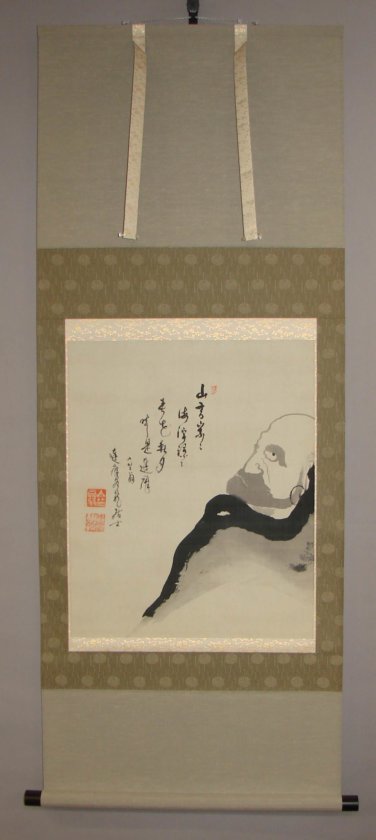Restoration Request for Daruma / Bodhidharma Kakejiku from Canadian Customer

Restoration Request for A Daruma / Bodhidharma Kakejiku from A Canadian Customer
Contents
Restoration Request for A Daruma / Bodhidharma Kakejiku from A Canadian Customer
The topic for this time is a remounting work for this kakekiju.

A request we received this time is from a Canadian customer. Quite a lot of orders from Canada have been received. That’s my impression.
Once we took an order for mounting four artworks and that request had come from Canada as well.
On that job, we mounted each of four artworks portraying ‘Lion and Peony’, ‘Jizō Bosatsu’, ‘Fudō Myōō’ and ‘Fox’ into a kakejiku.
The episode of this particular work is available to read. Visit the link below if you are interested.
The Canadian customer who placed the order is a painter and given another request from Canada this time, perhaps Japanese painting and kakejiku culture have been catching on in Canada. – If so, I’ll be glad about it.
The episode I am introducing this time is a restoration work for a kakejiku carried out a little while ago.
It was around autumn in 2019, still in the pre-corona era.
The customer who visited Japan on holiday sent a kakejiku to our company by Japanese postal service while he was traveling around this country.
All of the processes went smoothly thanks to the customer’s smart action, already getting in touch with us before arriving in Japan. I was very much impressed by his vitality as he brought the kakejiku to be restored to a foreign land with him then arranged the delivery to a kakejiku shop with a domestic carrier so as to, in the meantime, enjoy what Japan has to offer… I questioned to myself ‘Would I do the same?’ and the answer was most certainly no. I felt the energy of foreigners spending for a situation of this sort.
The customer told me he enjoyed himself by visiting all over Japan during his half a month stay.
I had advance arrangements for the remounting work with the customer showing the result images by email exchanges and that was rather amusing as he kept me updated with his travel report.
He even traveled to Wajima City, Ishikawa Prefecture and I must say it is proving his chic taste. The very cultured destination appears to be hard on the list of must to go places in Japan for first-time foreign holidaymakers but I assume they have their own preference down to their sense. Foreign travelers hop around places of their own choice so it was refreshing and fun to hear his real-time journey report on this occasion.
Restoration of A Daruma / Bodhidharma Kakejiku

The request we received this time is a restoration of a Daruma / Bodhidharma Kakejiku.
Daruma is a monk originally from India credited with an introduction of Zen Buddhism to China at the Sui or Tang Dynasty.
The Zen Buddhism led to Sōtō shū or Rinzai shū the Japanese Zen Buddhism after arriving to Japan.
The kakejiku with a motif of Daruma the founder of Zen Buddhism are typically displayed among Zen sects. These details are available at the introduction of Buddhist kakejiku so if you are interested, visit the link below.
This artwork is painted on silk but the glue used at the backing process has been weakened and the artwork is about to peel off the backing paper.

On top of that, a few stains and the unclean state of the artwork are spoiling the handsome Daruma.

Our work this time is remounting this kakejiku including stain removal.
Daruma Kakejiku Restoration Process
A broad process of the remounting work is shown below.
Dismantling the kakejiku – Remove the old fabric / detach the rod etc.
↓
Removing the old backing paper – A jargon for the procedure is ‘mekuru’ or ‘mekuri’.
↓
Cleaning the artwork – Dirt removal
↓
Removing stains – Stain removal for stains that still remained after the cleaning
↓
Remounting
Completion of the Restoration and Remounting

At last, we are finished with the Canadian customer’s order, the restoration and remounting work for his Daruma kakejiku.
Having the remounting job done, the kakejiku initially in a rather shabby state with its backing paper peeling off reborn as the one which looks crisply cool.
The chosen mounting fabric has a sober colored pattern so that it matches with the portrayal of Daruma painted in simply one sumi in an austere style.
Having the stain removal and being transformed into a chic one, Daruma seems even more good-looking to me.

The customer has already come back to his country after his holiday in Japan. Therefore I sent the kakejiku to him in no time.
We received a following feedback from him at a later date.
Nomura-san,
I received the Daruma kakejiku today, in perfect condition, and it is really beautiful.
I am so happy, thank you very much. I want to show it to my friends.
It was a pleasure doing business with you and I am to recommend you to anyone.
I’m truly glad that the customer sounds very much satisfied.
We take restoration and remounting requests of your kakejiku, like the episode this time, from all over the world.
Please feel free to contact us if you have any inquiries concerning your kakejiku.




